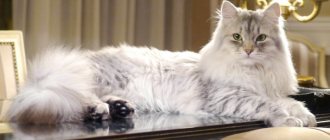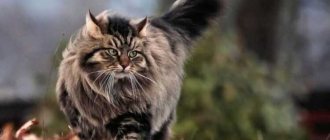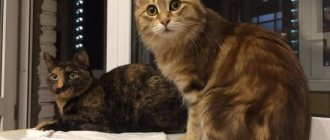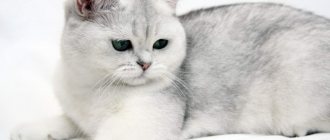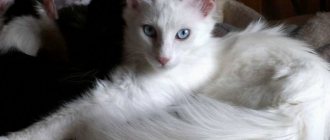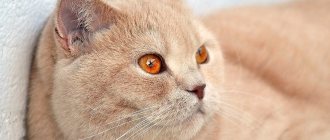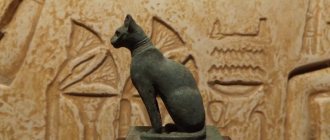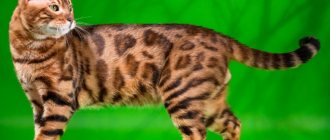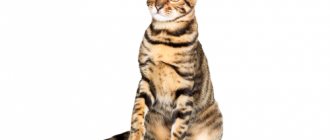Origin of the toyger
In the late 1980s, Judy Sudgen began breeding cats that shared phenotypic characteristics with the tiger. The breeder was able to highlight the striped coat so that the stripes on the body ran down and were also present on the muzzle and temples, creating a typical brindle appearance.
The progenitors that gave rise to this breed are the Bengal cat Millwood Rumpled Spotskin and the domestic cat Scrapmetal.
Since 2007, the result of selection has been officially named the California Toyger.
- The standard defines the Toyger as a “designer” cat.
- Breeders portray the purpose of their breeding through transformation, that is, by creating images of the ideal appearance of the Toyger.
- In this way they try to achieve and optimize the end result: a tiger in the living room of a reduced size.
Approximate prices for tiger kittens
Tiger kittens are sold in nurseries. Prices depend on the breed.
| Breed | Price, rub.) |
| Toyger | 60,000. For breeding they cost 200,000 rubles, as they are imported from foreign nurseries |
| Oncilla | 140000 |
| Bengal cat | 70000 |
| Tabby | 70000 |
| Sokoke | 60000 |
| Savannah | 500000 |
| Egyptian Mau | 100000 |
| Asherah | 4000000 |
External characteristics
Toygers only exist with brown tabby stripes. The exact definition of this design is Brown Tabby Mackarel. The short, very silky coat is only partially reminiscent of brindle.
A photo of a Toyger shows that it is a medium-sized cat with an athletic, muscular and slender build, with a broad chest, medium-length legs and large, strong paws.
- A female miniature tiger can weigh up to 3.5 kg, a male - 4.5 kg.
- His appearance is energetic, as expected of a tiger.
- The legs are large, the distance between the body and the floor is the same along the entire length of the body.
- The toyger's head is deep and wide, with the ears typically small and round, as are the eyes.
- The chin is very pronounced, and the nose is long and wide.
Toyger character
The character of the Toyger is described as very pleasant: playful, affectionate, very curious and with a pronounced intelligence. The toyger was bred specifically to live indoors and, unlike the tiger, does not necessarily need to spend time outdoors.
At the same time, walks in a safe garden or on a balcony equipped with a protective net are encouraged. This tiger cub can lead a happy and breed-appropriate life as an apartment cat, at home and in the city.
Clever Toygers easily interact with other pets and get along well with parrots, other cats and even dogs. Responsibility and excessive jealousy are unusual for them, which means that the Toyger cat will not behave aggressively or intrusively in order to attract the attention of the owner.
A pleasant bonus of the toyger is his unique purring, which he happily devotes to a person. By nature, the toyger is not so much a hunter cat, but a pleasant cat to talk to.
- If on the one hand his appearance resembles a large Asian cat, on the other he has the character of a gentle domestic cat, and it is this duality that fascinates his fans and owners.
- However, it is important to offer this intelligent, curious and playful animal the opportunity to have fun through cat brain games and other forms of entertainment through which it can show off its best skills.
Cat agility and clicker training are two great ways to test this smart cat's mental abilities. Play is also very important to the Toyger, as are long hugs from his human friends.
To be happy over the long term, a feline pet must lead a life that suits its personality and abilities, as well as meets its needs.
Hygiene and health
This robust cat with the appearance of a small tiger should, like all other felines, be regularly seen by a veterinarian, vaccinated and checked for common feline parasites.
- Cats of this breed are completely unpretentious and do not require special care or much effort from their owners.
- This fact has a good effect on the popularity of the breed, since its representatives are excellent for those who have little free time to care for the animal.
- The main thing in caring for a Toyger is creating a diet suitable for the animal and following it.
- The Toyger is short-haired, and from time to time it is customary to brush it with a soft cat brush.
There are no known hereditary diseases specific to this breed, which generally boasts excellent health.
Nurseries
The breed is still in the development stage; acquiring a small tiger cub is not easy. The creator of the Toyger, Judy Sugden, has developed a number of strict requirements for breeders. Their activities are aimed at creating and consolidating the tiger color while maintaining good health and long life expectancy for animals. There are about 50 certified nurseries in the world, and there are several in Russia.
One of the most famous - Greencity (Greencity) - is located in the city of Zelenograd, Moscow region. Toyger kittens were donated here directly by the author of the breed.
Other famous nurseries in Moscow:
- Moscow Family (Moscow Family);
- FairyBerendey (Fairy Berendey);
- Wild Jungle (Wild Jungle).
Another organization - Goldenspark (Goldenspark) - is located in the city of Engels, Saratov region.
How to feed a toyger
A cat is an absolutely predatory animal. If we look at his natural eating habits, the percentage of meat that a cat consumes in his diet is very high. The diet for cats should include mainly meat and offal.
- Many consider this approach to be the most appropriate type of diet for a cat from a biological point of view, since it is as close as possible to feeding a cat in nature.
- When preparing dishes according to BARF criteria, it is also not recommended to use regular table salt, but only sea or Himalayan salt.
If you don’t have time to formulate a diet yourself, then you should trust more traditional wet food for cats, which for many form the basis of the diet.
When assessing the quality of Toyger cat food, the percentage of protein it contains is of great importance. If you decide to feed your cat mostly commercial food, remember that the animal will need to meet its fluid needs in another way. For example, you can have a drinking fountain for cats and bowls in different areas of the house.
Eating and drinking in different places is part of a cat's natural habits. Your beloved feline should find conditions similar to those found in nature, even in the home: a cat that lives the way it does is a happy cat.
Keeping at home
The tiger cat does not show aggression towards people, but few people have succeeded in turning a wild animal into a domestic cat. A tiger cat will never be a cute pet. The animal loves solitude, is very active at night, has increased jumping ability, during the day it tries to hide on some hill, and has long, sharp claws. Due to their behavioral characteristics, a suitable place for keeping an oncilla will be a spacious enclosure, in which conditions will be created that are close to the natural environment familiar to these animals.
